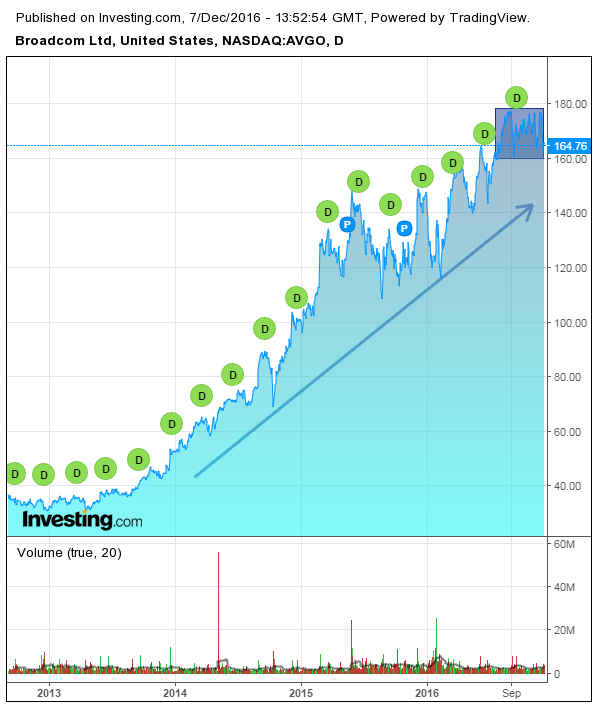by Eli Wright
Risk-on sentiment is back with a vengeance. Global equity markets were mostly higher yesterday, with Wall Street in particular setting new records. Yesterday, European markets all finished the day higher. Even gold improved slightly, and though the yellow metal has been on a firm downtrend, there may be room for some cautious optimism regarding a rebound before the end of the year. Now it's the healthcare sector's turn to run scared after President-elect Trump’s statements in a newly published Time magazine article focused a white-hot spotlight on high drug prices, grabbing headlines.
Asian markets closed mostly higher, on the tailwinds of US all-time highs. In overnight trading, the Nikkei gained 1.45%, to close at 18,765.47. The Hang Seng closed higher as well, up 0.15%, to 22,835. Only the Shanghai Composite lost some ground, falling 0.21% to 3,215.45 as Chinese trade balance figures came in lower than expected.
In Europe this morning, markets continued the exuberance. The FTSE is currently trading up 0.14%, at 6,912; the DAX is up 0.59% at 11,051.50; and the Euro Stoxx 50 is 0.52% higher, at 3,154.50.
But it's Wall Street that's really jumping. The Dow hit yet another record yesterday, closing up 1.55% to 19,549.62, prompting some analysts to speculate that the index might just hit 20,000 before the start of 2017. The S&P 500 also hit an all-time high intraday, closing at a record level as well: up 1.32%, to 2,241.35. Even the Dow Jones Transportation hit new highs. The NASDAQ, performed will but is still hitting some resistance to new record highs, gained 1.14%, to 5,393.76.
In pre-market trading, the Dow and the S&P are relatively flat, up 0.04% while the NASDAQ is up 0.11%.
US Treasury yields fell across the board: the 2-year note fell to 1.108%; the 10-year note dropped to 2.347%; and the 30-year bond fell to 3.031%.
Forex
The dollar was weaker in daily trading against a trade-weighted basket of currencies. Just this morning the Dollar Index fell below the psychologically important 100 threshold.
The European Central Bank meets this morning to decide interest rates, but it is widely expected that they will extend their QE program. This divergence from US monetary policy, in which the Fed is likely to raise rates next week, leaves analysts inclined to believe that longer-term the euro will continue losing ground to the dollar. At the time of last June's Brexit vote, the single currency was trading at $1.14. Post-US election, the pair has fallen to $1.07.
The dollar's strength doesn't just move FX markets. Long-term policy divergence, and a move closer to EUR/USD parity, also impacts multi-national companies. International firms that rely on US exports could face profit headwinds as products they sell become more expensive, while companies that export to the US could benefit if their goods and services become more affordable.

Source: WSJ
Commodities
Oil slid yet again yesterday on speculation that US shale production will ramp up. “The return of OPEC does not signal a return to a raging bull market,” Seth Kleinman, head of energy strategy at Citigroup in London, said in a report. “The game has changed. There is a new swing producer in town in the form of U.S. shale.” Also contributing to the drop in oil prices are signs that OPEC, in trying to work out a deal with non-members to cut production, will not insist on deliberate reductions, but will instead also accept natural output declines – thought it's not clear what that actually means.
Gold edged higher yesterday. It's currently trading at $1,177.65. Still, with markets firmly signaling risk-on mode for now, the precious metals bear market could linger. However, some analysts see a possible bounce for gold in the coming weeks, should the dollar fade after the Fed raises rates this year without providing a firm timetable for follow-up hikes.
Gold could also soon see increased demand from the world’s 1.6 billion Muslims, as the long-awaited specifics for Islam's Shariah Gold Standard were released on Monday. Until now, under Shariah law, it was difficult for religious investors to trade in gold. However, Muslim scholars in tandem with the World Gold Council have developed a workaround, providing potential entry into the PM market for a quarter of the world’s population.
Stocks
Healthcare stocks, which until now haven't been on the President-elect's radar, moved lower yesterday after Trump, Time Magazine’s Man of the Year, told the publication, in an interview published to coincide with the announcement, that he would crack down on Big Pharma. “I’m going to bring down drug prices. I don’t like what’s happened with drug prices,” Trump said. The interview was posted on Time’s website (link above).
The S&P Biotech ETF (NYSE:XBI) tumbled more than five percent on the news.

Source: Fidelity.com
On the day yesterday, biotech stocks in the S&P 500 lost 2.07% while pharma companies lost 0.91%. Celgene (NASDAQ:CELG) lost more than 4%; Mylan (NASDAQ:MYL) fell 3.8%; and Amgen (NASDAQ:AMGN) declined 2.7%. Even distributors felt the pinch: AmerisourceBergen (NYSE:ABC) was down 3.16%.
Earnings reports later today include:
Broadcom (NASDAQ:AVGO), one of the largest semi-conductor companies in the world, reports earnings after the market closes. Expected Q4 2016 EPS is $3.38 on $4.12 billion in revenue. During the past five quarters, the company has exceeded analyst expectations by an average of 5.2%.
Broadcom has four revenue streams: wired, wireless, enterprise storage, and industrial solutions.
The wired segment, which includes ethernet switching, routing, and broadband products brings in over 50% of company revenue. Growth in this segment has been flat through the previous three quarters, but as Broadcom’s largest revenue contributor, even a small increase could significantly boost profits.
The wireless segment provides a further 25% of overall revenue, mainly off components for Apple’s (NASDAQ:AAPL) iPhones. For much of the year, iPhone sales struggled, but this past quarter Apple reported a 17% increase in sales, prompting Broadcom to upgrade its guidance for the fourth quarter. And with many analysts assuming a better outlook for Apple’s next iteration of the iPhone, which could include additional AVGO components, this segment might have the most future growth potential for Broadcom.
Broadcom’s enterprise storage division, which includes products such as hard disk drives and servers, accounts for about 13% of overall company revenue. Broadcom is expecting minimal growth in this segment this quarter, but with the market shifting to solid-state drives and cloud computing, Broadcom might need to rethink strategy here in order to sustain growth. It’s unclear how their early-November, $5.9 billion acquisition of Brocade Communications (NASDAQ:BRCD) will help them here, beyond generating some short-term cash flow.
Broadcom’s smallest segment, industrial solutions, includes sensors, fiber optics, displays, and IPs. Broadcom competes with Texas Instruments (NASDAQ:TXN) and Analog Devices (NASDAQ:ADI) in this space and both those companies reported revenue falls for their industrial segments; Broadcom expects a decline this quarter as well.

Though Broadcom's stock has been on a four-year uptrend, shares have been consolidating within a $160-180 range, moving sideways throughout the recent five-month period. Broadcom is down 2.81% on the month. However, year-to-date, it's gained over 16%, up 3.5 percent on the week, ahead of the earnings report.
